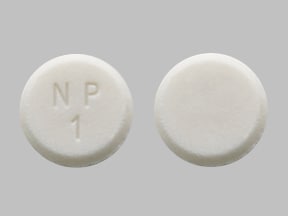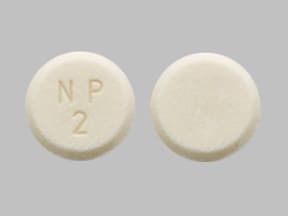Rayos
Generic name: prednisone
Drug class: Glucocorticoids
What is Rayos used for?
Rayos is a prescription medicine that is used for many health problems like allergy signs, asthma, adrenal gland problems, blood problems, skin rashes, or swelling problems. This is not a list of all health problems that this medicine (Rayos) may be used for.
Description
The active ingredient in RAYOS is prednisone (a corticosteroid). Corticosteroids are adrenocortical steroids, both naturally occurring and synthetic. The molecular formula for prednisone is C21H26O5. The chemical name for prednisone is 17,21-dihydroxypregna-1,4-diene-3,11,20-trione, and the structural formula is:

Prednisone is a white to practically white, odorless, crystalline powder and has a molecular weight of 358.43. Prednisone is very slightly soluble in water; slightly soluble in alcohol, chloroform, dioxane, and methanol.
RAYOS is a delayed-release prednisone tablet. It consists of a prednisone-containing core tablet in an inactive shell, which delays the onset of in vitro drug dissolution by approximately 4 hours. Each tablet contains 1 mg, 2 mg, or 5 mg of prednisone, with the following inactive ingredients: dibasic calcium phosphate dihydrate, colloidal silicon dioxide, croscarmellose sodium, glycerol dibehenate, lactose monohydrate, magnesium stearate, povidone, yellow ferric oxide, and red ferric oxide.
Mechanism of Action
Naturally occurring corticosteroids (hydrocortisone and cortisone), which also have salt-retaining properties, are used as replacement therapy in adrenocortical deficiency states. Their synthetic analogs, such as prednisone, are primarily used for their potent anti-inflammatory effects in disorders of many organ systems.
Corticosteroids, such as prednisone, cause profound and varied metabolic effects. In addition, they modify the body’s immune responses to diverse stimuli.
Prednisone is a synthetic adrenocortical steroid drug with predominantly corticosteroid properties. Some of these properties reproduce the physiological actions of endogenous glucocorticosteroids, but others do not necessarily reflect any of the adrenal hormones’ normal functions; they are seen only after administration of large therapeutic doses of the drug. The pharmacological effects of prednisone which are due to its corticosteroid properties include: promotion of gluconeogenesis; increased deposition of glycogen in the liver; inhibition of the utilization of glucose; anti-insulin activity; increased catabolism of protein; increased lipolysis; stimulation of fat synthesis and storage; increased glomerular filtration rate and resulting increase in urinary excretion of urate (creatinine excretion remains unchanged); and increased calcium excretion.
Depressed production of eosinophils and lymphocytes occurs, but erythropoiesis and production of polymorphonuclear leukocytes are stimulated. Inflammatory processes (edema, fibrin deposition, capillary dilatation, migration of leukocytes and phagocytosis) and the later stages of wound healing (capillary proliferation, deposition of collagen, cicatrization) are inhibited.
Prednisone can stimulate secretion of various components of gastric juice. Suppression of the production of corticotropin may lead to suppression of endogenous corticosteroids. Prednisone has slight mineralocorticoid activity, whereby entry of sodium into cells and loss of intracellular potassium is stimulated. This is particularly evident in the kidney, where rapid ion exchange leads to sodium retention and hypertension.
Before taking Rayos, tell your doctor:
- If you are allergic to this medicine (Rayos); any part of this medicine (Rayos); or any other drugs, foods, or substances. Tell your doctor about the allergy and what signs you had.
- If you have a herpes infection of the eye.
- If you have any of these health problems: A fungal infection or malaria infection in the brain.
- If you have recently spent time in the tropics and have unexplained diarrhea.
- If you have nerve problems in the eye.
- If you are breast-feeding or plan to breast-feed.
This is not a list of all drugs or health problems that interact with this medicine (Rayos).
Tell your doctor and pharmacist about all of your drugs (prescription or OTC, natural products, vitamins) and health problems. You must check to make sure that it is safe for you to take this medicine (Rayos) with all of your drugs and health problems. Do not start, stop, or change the dose of any drug without checking with your doctor.
What are some things I need to know or do while I take Rayos?
- Tell all of your health care providers that you take this medicine (Rayos). This includes your doctors, nurses, pharmacists, and dentists.
- Have blood work checked as you have been told by the doctor. Talk with the doctor.
- This medicine may affect allergy skin tests. Be sure your doctor and lab workers know you take this medicine (Rayos).
- You may have more of a chance of getting an infection. Wash hands often. Stay away from people with infections, colds, or flu. Some infections have been very bad and even deadly.
- Call your doctor right away if you have any signs of infection like fever, chills, flu-like signs, very bad sore throat, ear or sinus pain, cough, more sputum or change in color of sputum, pain with passing urine, mouth sores, or a wound that will not heal.
- Chickenpox and measles can be very bad or even deadly in some people taking steroid drugs like this medicine (Rayos). Avoid being near anyone with chickenpox or measles if you have not had these health problems before. If you have been exposed to chickenpox or measles, talk with your doctor.
- If you have or may have threadworms, talk with your doctor.
- This medicine lowers how much natural steroid your body makes. Tell your doctor if you have fever, infection, surgery, or injury. Your body’s normal response to these stresses may be affected. You may need extra doses of steroid.
- High blood pressure has happened with drugs like this one. Have your blood pressure checked as you have been told by your doctor.
- Long-term use may raise the chance of cataracts or glaucoma. Talk with the doctor.
- Have your eye pressure checked if you are on this medicine (Rayos) for a long time. Talk with your doctor.
- This medicine may cause weak bones (osteoporosis) with long-term use. Talk with your doctor to see if you have a higher chance of weak bones or if you have any questions.
- Have a bone density test as you have been told by your doctor. Talk with your doctor.
- Talk with your doctor before getting any vaccines. Use of some vaccines with this medicine (Rayos) may either raise the chance of an infection or make the vaccine not work as well.
- If you have high blood sugar (diabetes), you will need to watch your blood sugar closely. Tell your doctor if you get signs of high blood sugar like confusion, feeling sleepy, more thirst, more hungry, passing urine more often, flushing, fast breathing, or breath that smells like fruit.
- Talk with your doctor before you drink alcohol.
- If you are 65 or older, use this medicine (Rayos) with care. You could have more side effects.
- This medicine may affect growth in children and teens in some cases. They may need regular growth checks. Talk with the doctor.
- Tell your doctor if you are pregnant or plan on getting pregnant. You will need to talk about the benefits and risks of using this medicine (Rayos) while you are pregnant.
- If you used this medicine (Rayos) when you were pregnant, tell your baby’s doctor.
How is Rayos best taken?
Use this medicine (Rayos) as ordered by your doctor. Read all information given to you. Follow all instructions closely.
- Take this medicine (Rayos) with food or milk.
- Take in the morning if taking once a day.
- Swallow whole. Do not chew, break, or crush.
- Keep taking this medicine (Rayos) as you have been told by your doctor or other health care provider, even if you feel well.
- Do not stop taking this medicine (Rayos) all of a sudden without calling your doctor. You may have a greater risk of side effects. If you need to stop this medicine (Rayos), you will want to slowly stop it as ordered by your doctor.
- You may need to lower how much salt is in your diet and take extra potassium. Talk with your doctor.
What do I do if I miss a dose?
- Take a missed dose as soon as you think about it.
- If it is close to the time for your next dose, skip the missed dose and go back to your normal time.
- Do not take 2 doses at the same time or extra doses.
What are the side effects of Rayos that I need to call my doctor about immediately?
WARNING/CAUTION: Even though it may be rare, some people may have very bad and sometimes deadly side effects when taking a drug. Tell your doctor or get medical help right away if you have any of the following signs or symptoms that may be related to a very bad side effect:
- Signs of an allergic reaction, like rash; hives; itching; red, swollen, blistered, or peeling skin with or without fever; wheezing; tightness in the chest or throat; trouble breathing, swallowing, or talking; unusual hoarseness; or swelling of the mouth, face, lips, tongue, or throat.
- Signs of low potassium levels like muscle pain or weakness, muscle cramps, or a heartbeat that does not feel normal.
- Signs of a pancreas problem (pancreatitis) like very bad stomach pain, very bad back pain, or very bad upset stomach or throwing up.
- Signs of high or low blood pressure like very bad headache or dizziness, passing out, or change in eyesight.
- Signs of a weak adrenal gland like a very bad upset stomach or throwing up, very bad dizziness or passing out, muscle weakness, feeling very tired, mood changes, not hungry, or weight loss.
- Signs of Cushing’s disease like weight gain in the upper back or belly, moon face, very bad headache, or slow healing.
- Feeling very tired, weak, or touchy; trembling; having a fast heartbeat, confusion, sweating, or dizziness if you missed a dose or recently stopped this medicine (Rayos).
- Shortness of breath, a big weight gain, or swelling in the arms or legs.
- Skin changes (pimples, stretch marks, slow healing, hair growth).
- Fast, slow, or abnormal heartbeat.
- Chest pain or pressure.
- Swelling, warmth, numbness, change of color, or pain in a leg or arm.
- Period (menstrual) changes.
- Bone or joint pain.
- Feeling very tired or weak.
- Change in eyesight.
- Feeling confused, not able to focus, or change in behavior.
- Mood changes.
- Memory problems or loss.
- Hallucinations (seeing or hearing things that are not there).
- Seizures.
- A burning, numbness, or tingling feeling that is not normal.
- Very bad belly pain.
- Any unexplained bruising or bleeding.
- Black, tarry, or bloody stools.
- Throwing up blood or throw up that looks like coffee grounds.
What are some other side effects of Rayos?
All drugs may cause side effects. However, many people have no side effects or only have minor side effects. Call your doctor or get medical help if any of these side effects or any other side effects bother you or do not go away:
- Upset stomach or throwing up.
- Trouble sleeping.
- Restlessness.
- Sweating a lot.
- Dizziness.
- Headache.
These are not all of the side effects that may occur. If you have questions about side effects, call your doctor. Call your doctor for medical advice about side effects.
You may report side effects to the FDA at 1-800-332-1088. You may also report side effects at https://www.fda.gov/medwatch.
If overdose is suspected:
If you think there has been an overdose, call your poison control center or get medical care right away. Be ready to tell or show what was taken, how much, and when it happened.
How do I store and/or throw out Rayos?
- Store at room temperature.
- Store in a dry place. Do not store in a bathroom.
- Keep all drugs in a safe place. Keep all drugs out of the reach of children and pets.
- Throw away unused or expired drugs. Do not flush down a toilet or pour down a drain unless you are told to do so. Check with your pharmacist if you have questions about the best way to throw out drugs. There may be drug take-back programs in your area.
Label
PRINCIPAL DISPLAY PANEL – 1 MG TABLET BOTTLE CARTON
- NDC 75987-020-01
- RAYOS®
(Prednisone) Delayed-release Tablets - 1 mg
30 Tablets - Swallow whole. Do not crush,
divide, or chew tablets. - Rx Only
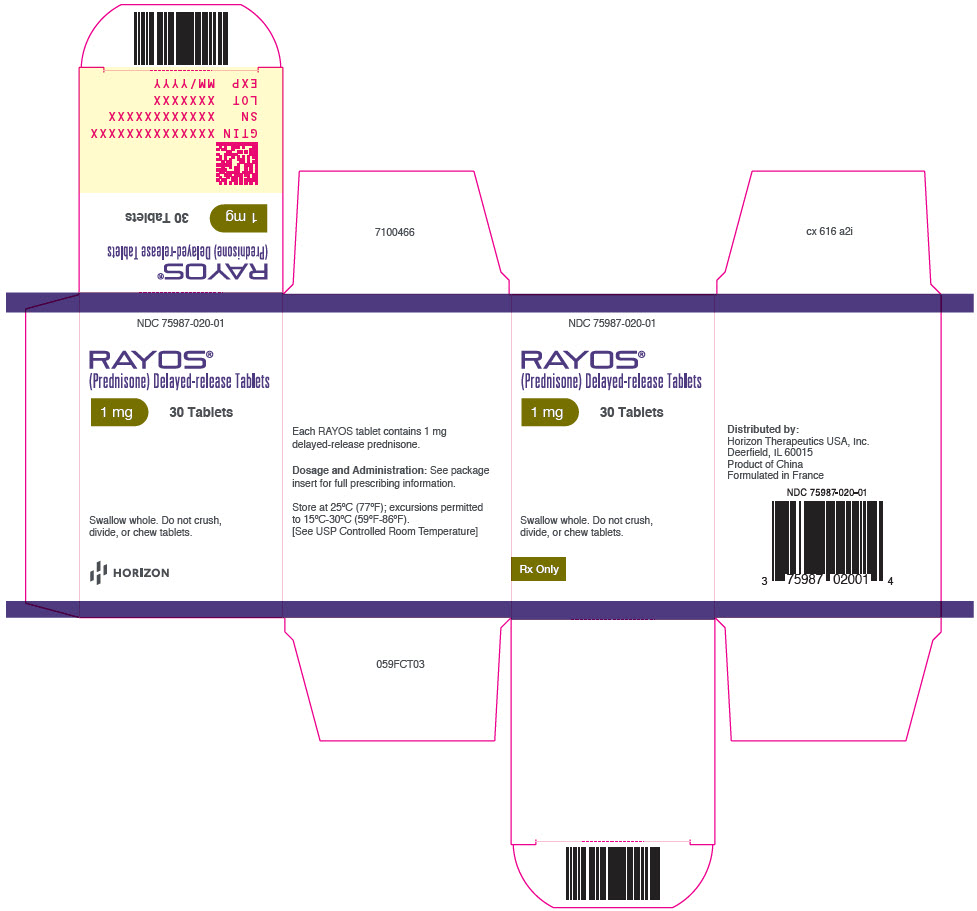
PRINCIPAL DISPLAY PANEL – 2 MG TABLET BOTTLE CARTON
- NDC 75987-021-01
- RAYOS®
(Prednisone) Delayed-release Tablets - 2 mg
30 Tablets - Swallow whole. Do not crush,
divide, or chew tablets. - Rx Only
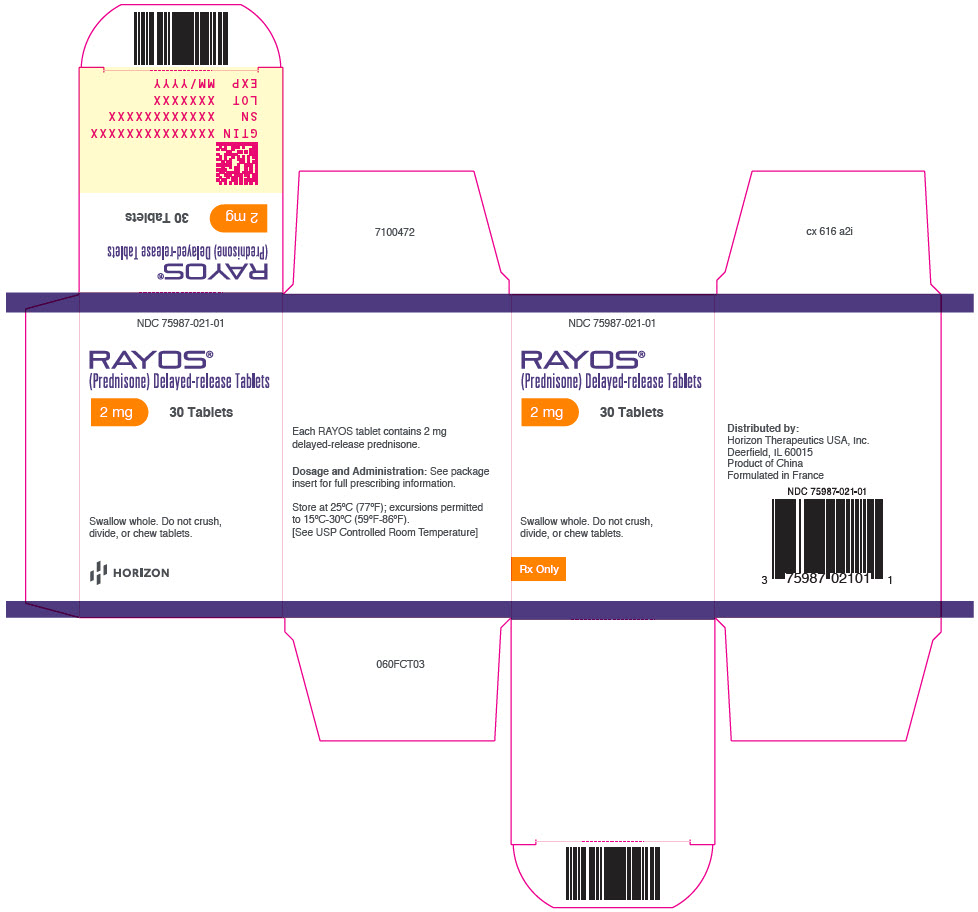
PRINCIPAL DISPLAY PANEL – 5 MG TABLET BOTTLE CARTON
- NDC 75987-022-01
- RAYOS®
(Prednisone) Delayed-release Tablets - 5 mg
30 Tablets - Swallow whole. Do not crush,
divide, or chew tablets. - Rx Only

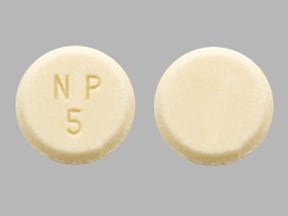
SRC: NLM .

